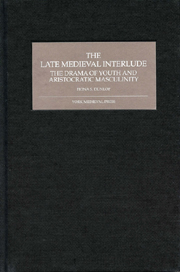Book contents
- Frontmatter
- Contents
- Dedication
- Acknowledgements
- List of Abbreviations
- Introduction: The interlude as a literary genre
- 1 Defining Youth
- 2 Young Masculinity and Late Medieval Discourses of Youth
- 3 Noble Masculinity in the Interludes
- 4 Interludes and the Politics of Youth
- Conclusion
- Bibliography
- Index
- YORK MEDIEVAL PRESS: PUBLICATIONS
1 - Defining Youth
Published online by Cambridge University Press: 05 February 2013
- Frontmatter
- Contents
- Dedication
- Acknowledgements
- List of Abbreviations
- Introduction: The interlude as a literary genre
- 1 Defining Youth
- 2 Young Masculinity and Late Medieval Discourses of Youth
- 3 Noble Masculinity in the Interludes
- 4 Interludes and the Politics of Youth
- Conclusion
- Bibliography
- Index
- YORK MEDIEVAL PRESS: PUBLICATIONS
Summary
Early interludes did not invent a concept of youth. Their depiction of the young is informed by several intersecting traditions of thought about age and ageing, ideas so familiar to the audience that they do not need to be spelled out. The unspoken principles on which the representations rest have important implications for our understanding of the young men of the plays. Late medieval theories of the development of male bodies constituted youth first of all as a biological category.
Late medieval knowledge about age and ageing was articulated most succinctly in schemes of the Ages of Man, a means of presenting the body's growth and development in a paradigmatic, universalizing form. Ages of Man schemes construct a model of the typical life-span which divides it up into stages. Each stage of life, or “Age”, is defined in terms of years and labelled with a specific name. Three early interludes evidently adopt this structural principle in their presentation of a universal central figure: two – Nature and The Worlde and the Chylde – depict the complete life-cycle of their male protagonists, Man and Infans, so that as the plays progress we see them grow from childhood to old age, passing through identifiable Ages. The Interlude of Youth depicts one stage from that life-cycle.
- Type
- Chapter
- Information
- The Late Medieval InterludeThe Drama of Youth and Aristocratic Masculinity, pp. 9 - 21Publisher: Boydell & BrewerPrint publication year: 2007



